
UPCOMING: June 16-22 2025 ~ (Rotterdam, the Netherlands) :: LIVE in WORM :: HAROLD SCHELLINX Post-Post ULTRA (van 1983 tot en dan almaar verdur) :: (it is all) Politics >:> eternity, unPublic, sudoku's, Commuters, 1024, k7, collage, Gentle Slaughter ... Concert on Saturday, June 21. Drinks on Sunday 22!!
SUBSCRIBE to soundblog_un_public our personal / private old-school email newsletter alternative to the use of FB, X, Insta and other surveilling & exploiting media. Our occasional newsletter brings web links to new and not-so-new thoughts, to releases, concert dates, texts related to projects / works by Har$, the ookoi, other collabs, etc.
7 mins read 🤓
“Let me show you exactly what you are”
( Sudoku 3, for double bass )
january 3, 2025
“ alle tijden zijn tijden
die van het eerder ja, dat waren eens;
maar geef mij liever later, wat nog gaat zullen zijn ”
“His model-of-a-brain ran seventeen times slower than the real thing,” we learn at the beginning of Greg Egan's hard-sci-fi novel Permutation City. Then, later on, with ‘dusk falling over the recorded city’, the protagonist listens to music. “It made no difference that each note ‘really‘ lasted seventeen times as long as it should have. He listened until long after midnight.”
At the time that I was reading Egan's story I was also scoring ‘Sudoku 3’ for double bass, a first in a series of pieces made from sudoku solutions for acoustic / ‘classical‘ instruments. The above passage inspired the making of an ‘electronic‘ surrounding for the double bass's solo, a four channel sound track, built from an online bit of generative music/sound, pretty much picked au hasard from a folder with sound files of unknown, only vaguely known or forgotten origin on my computer. The original lasted four minutes. I cut it up into four one-minute parts, and stretched each of them to last for seventeen minutes ... ‘time running seventeen times slower‘.
It was a perfect fit (in één keer goed) for an extremely slow (36 bpm, grave) rendition of the double bass solo part.
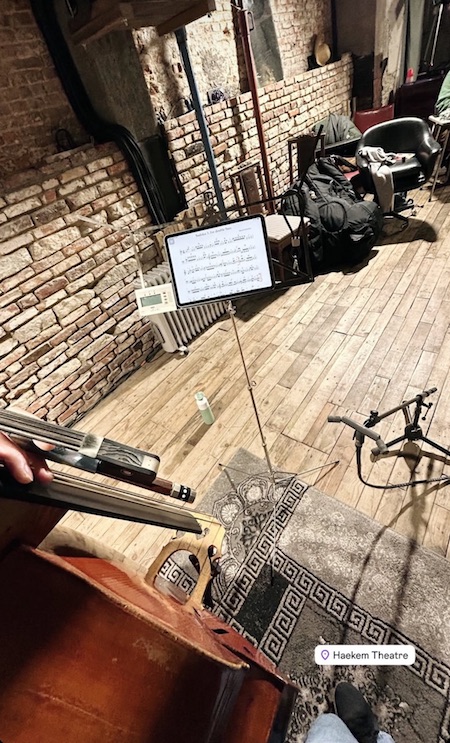
On Sunday December 15th with Shin-wen Lee playing the double bass we did a first section-by-section run-through and recording of the instrumental part, in the wonderful underground performance space of the Haekem theatre in Brussels, with the indispensable help and support of Gérard Daval who also did the recording engineer's work ánd offered us some fine coffee in the breaks.
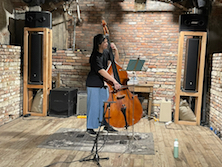 |
 |
Around Xmas in Amsterdam I edited these recordings, and put them together with the electronic voices into a first full version of the piece.
Here are the formal details of the ‘construction’ of the double bass solo. The solo is in three parts, each of which is extracted from the third of the 52 sudoku solutions that I used over the year 2020 when I recorded a K7-sudoku every week. The original idea (as written in my little red sudoku notebook) was to also compose 52 instrumental pieces with the same 52 sudokus.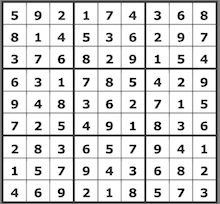 The one used for the double bass solo is that of the third week of 2020. (The corresponding K7-sudoku is called ‘À quatorze heures’, it is the twelfth track on the second volume of my selection of K7-sudoku's from that year.) Whether that original idea will ever come to be fully realised remains to be seen, but is unlikely. Too many other and alternative approaches that keep popping into my head. But here then at the very least there is sudoku202003, exploited (interpreted) as a score for a double bass solo.
The one used for the double bass solo is that of the third week of 2020. (The corresponding K7-sudoku is called ‘À quatorze heures’, it is the twelfth track on the second volume of my selection of K7-sudoku's from that year.) Whether that original idea will ever come to be fully realised remains to be seen, but is unlikely. Too many other and alternative approaches that keep popping into my head. But here then at the very least there is sudoku202003, exploited (interpreted) as a score for a double bass solo.
The first part of the solo follows the same interpretation of the sudoku as that explained already in the text about the variations for perished piano. For the pitches, a column is read from top to bottom, followed by the reading of the corresponding row from right to left (in the order given by the pre-mutation in the sudoku's 4th row: (6,3,1,7,8,5,4,2,9): the piece starts with column/row number 6, then column/row number 3, and so on, until column/row number 9). The numbers of the sudoku-grid are interpreted as denoting intervals in semi-tones, alternately with a plus- (going up) and with a minus-sign (going down), starting in the up-direction, from A3 (that is, midi note number 57). The sequence of durations (or rather: ‘entry points‘) is given by the matrix in a similar way, using the same column-row pair, but then read first as a row from left to right, followed by the corresponding column read from bottom to top. As explained in the 'perished piano' text, the result is a sequence of 162 notes that will always bite its own tail: it wanders from that A3 note, as if in a random walk, only to always land back there on that same note in the end, in precisely 2 × 81 = 162 steps, that together last 810 ticks. The following picture is a graphic representation of the pitch_duration contour of the first part of the double bass's sequence, followed by a few example bars from the score. The score's time signature is 9/16, where a 16th note corresponds to one tick and the nine reflects the standard sudoku's ‘nineness’, so in the score the interpretation of the 18 numbers in one column/row pair (90 ‘ticks‘) will correspond to precisely ten measures. The part's full set of notes therefore will be spread out over a total of 90 measures.

The red lines in the graph indicate the limits of the double bass's range. These, of course, are not absolute limits, but limits chosen so as to fit well with Shih-wen's instrument and her playing.
The sudoku walk obviously disregards such limits and steps well beyond the red lines. This can already can be seen in the graph of part 1. In the score the out-ot-range notes are not indicated. There is a 'wiggly line' and a mark (e.g. bb1, which stands for ‘buiten bereik 1’ or 'buiten boord 1' or 'buiten basbereik 1'; or for ‘blackbird 1’, as in the recording you will discover the outarange 'bb'-fragments as snippets taken from my collection of recordings of my favorite blackbird's singing.)
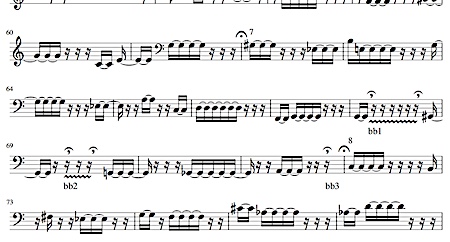
The second and third part of the double bass solo are again generated by the same ‘sudoku 2003’, but with a twist. In these parts I wanted the sequence of notes to be a lot less dense. 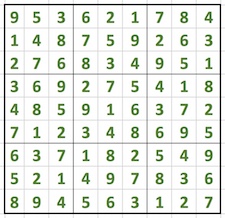 I therefore ‘filtered out’ part of the numbers in the sudoku grid, and interpreted the resulting empty cells in the matrix as rests.
For the second part, that filtering works as follows: I overlay the grid by a second matrix, the one you see here to the left. (It is a diagonal sudoku, sometimes also called an X-sudoku, as also the diagonals of the matrix are permutations of the numbers 1 to 9.) Now I empty a cell in my source sudoku if it contains the same number as the corresponding cell in the masking sudoku.
I therefore ‘filtered out’ part of the numbers in the sudoku grid, and interpreted the resulting empty cells in the matrix as rests.
For the second part, that filtering works as follows: I overlay the grid by a second matrix, the one you see here to the left. (It is a diagonal sudoku, sometimes also called an X-sudoku, as also the diagonals of the matrix are permutations of the numbers 1 to 9.) Now I empty a cell in my source sudoku if it contains the same number as the corresponding cell in the masking sudoku. 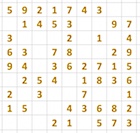 Then the X-sudoku is turned over 90 degrees in counter clockwise sense, and I repeat the procedure; then a second turn is performed, and I again repeat the emptying, and a third turn, repeat the emptying... This final, fourth result, is the sudoku grid that became the source for the second part of the double bass solo. Note that what we now have—the grid to the right—is not a sudoku solution, but rather a sudoku puzzle, of which sudoku2003 is a solution
Then the X-sudoku is turned over 90 degrees in counter clockwise sense, and I repeat the procedure; then a second turn is performed, and I again repeat the emptying, and a third turn, repeat the emptying... This final, fourth result, is the sudoku grid that became the source for the second part of the double bass solo. Note that what we now have—the grid to the right—is not a sudoku solution, but rather a sudoku puzzle, of which sudoku2003 is a solution
The empty cells in the grid become rests for the double bass, and you get the following pitch-duration graph. (The pitches are determined by the filtered sudoku grid, the durations by the corresponding column/rows in the filter (the) diagonal grid.)
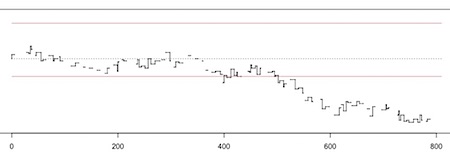
Note how here the sudoku walk leads well beyond the lower red barrier. In those regions some of the (on the bass) unsounding parts are true rests (these are the 'white' parts, the others are 'bb'-parts, falling outside the range of the double bass; this difference is reflected in the wiggly underlined bb-parts and the ‘true‘ rests in the following fragment of the score.
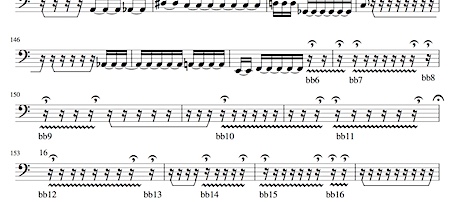
For the third and final part of the double bass's sequence I use the complement 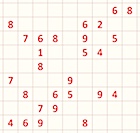 of the suduko puzzle grid used for the second part. The numbers here are precisely those missing in the second part, and the ones missing in the third part are the ones given by the second part. The puzzles are complementary, they are each other's solution: if we overlay the second part's grid and that of the third part, together they form the original sudoku solution. As a consequence, also the succession of these two parts will result in a cyclic sequence of notes. As we continue the second part from the A3 note that ended the first part, at the end of the third part we again fall back on the initial note, A3.
of the suduko puzzle grid used for the second part. The numbers here are precisely those missing in the second part, and the ones missing in the third part are the ones given by the second part. The puzzles are complementary, they are each other's solution: if we overlay the second part's grid and that of the third part, together they form the original sudoku solution. As a consequence, also the succession of these two parts will result in a cyclic sequence of notes. As we continue the second part from the A3 note that ended the first part, at the end of the third part we again fall back on the initial note, A3.

Everything put together, here is how a first version of the piece sounds:
Read all about Sudokism and Südokaising on the SoundBlog:
(2025, april 18) - A decom-.pomdipem~padopi~dompadé.-posed suso
(2025, march 01) - Full coloration set sudoku solution pieces
(2025, january 23) - ‘War drift’ for violoncello, and other sudoku, latin and costas grids
(2025, january 3) - “Let me show you exactly what you are” (Sudoku 3, for double bass)
(2024, july) - Uit de kast: "I am a Sudokist!"
(2021, september 11) - The Art of K7 :: Südokaising [ii] Time Folds
(2020, march 21) - The Art of K7 :: Südokaising [i]
(2006, april 17-25) - 'sudoku-solution' in 'de nor'
Read about Sudokism and Südokaising on Medium:
(2024, october) - Variations on a Sudoku Solution for Perished Piano
tags: sudokism, permutations
# .549.